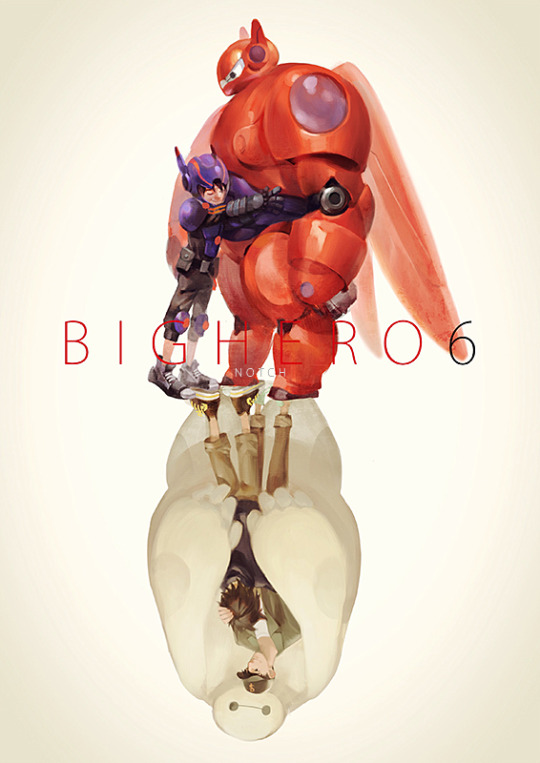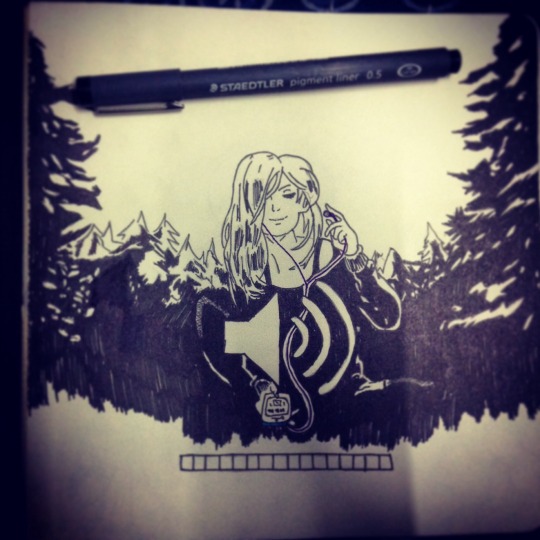Link
p style='text-align: justify;'Some implications and consequences of the expansion of the universe are examined. In Chapter 1 it is shown that this expansion creates grave difficulties for the Hoyle-Narlikar theory of gravitation. Chapter 2 deals with perturbations of an expanding homogeneous and isotropic universe. The conclusion is reached that galaxies cannot be formed as a result of the growth of perturbations that were initially small. The propogation and absorption of gravitational radiation is also investigated in this approximation. In Chapter 3 gravitational radiation in an expanding universe is examined by a method of asymptotic expansions. The 'peeling off' behaviour and the asymptotic group are derived. Chapter 4 deals with the occurrence of singularities in cosmological models. It is shown that a singularity is inevitable provided that certain very general conditions are satisfied./p
3 notes
·
View notes
Text
A Tocsin from UNICEF: Cyberbullying.
One of Six Demons.
During the early 1990s when the word “chat room” was used to describe online messaging, insults were simpler, more benign, a learning experience. They were named flaming.
FLAMING (flaming) n. 1. To engage in an inline argument usually involving unfounded personal attacks by one or more parties. [Urban Dictionary]
In an effort to “educate” newbies, a more seasoned user of the particular chat room would send off a sarcastic, sometimes hurtful but often creative comment — known as a flame. Take the case of the 1994 Moby, who asked Usenet group how he was supposed to bring a date home when his two cats were constantly puking or in heat. One user flamed, “Get a sense of humor, or a life. In that order.” followed by a silence and group exit by Moby. This “art of flaming” is illustrated in Virginia Shea’s book Netiquette where she explains in detail how an arrival of flame was signaled.
CYBERBULLYING (cyberbullying) n. 1. An advanced form of bullying; the electronic posting of mean-spirited comment about a person (such as a student) often done anonymously. Often takes a form of a meme, a troll, or even a picture.
[UNICEF (Child Online Protection in India)] & [Merriam-Webster Dictionary]
Megan Meier, a 13-year-old girl, had an online boyfriend named Josh Evans, he suddenly turned on her, writing “You are a bad person and everybody hates you…the world would be a better place without you.” Megan hanged herself in her bedroom wardrobe. A couple of blocks down, Lori Drew reportedly laughed when she heard of the suicide. She was masquerading online as the teenage boy to see if Megan was saying anything bad about her own daughter Sarah. The days following the county prosecutor discovered there was NO LAW on the books to make a case against Lori Drew, though the state of Missouri quickly passed laws on cyber-bullying for the future. For now, Lori Drew is sentenced to three years in prison and a $300,000 fine and the Megan Meier Cyberbullying Prevention Act is now pending in Congress, which will be too late for a young sad girl.
This is the evolution of flaming, from a decent sarcastic, or a SIGNALED flame to a life threatening and suicide involving comment. Cyberbullying is real, and it’s happening on a worldwide scale, a person sitting in Huston, Texas can make you question your existence in Aligarh, India.
“Cyberbullying is a ‘pernicious’ issue.” ~ Theresa May, UK Home Secretary
India, a developing country, where the DIGITAL ILLITERACY rate is more than 90% of the total population (source), the most common answer to a cyber threat is “ignore it” — the imperfect default due to this illiteracy! Sexting, abusing, violence, rape threats, and stalking is some of the major issues casting a dangerous shadow on Indian children, according to UNICEF.
A class 9 girl sent over 30 sexually explicit pictures to a boy in class 11, which he took as an invite from her and approached her to start a physical relationship. When she got scared and tried to back out, he threatened to make those pictures public. This case was taken to the school counselor where afterward the boy was held guilty and gave a written apology to the girl.
These incidents are easily labeled as privacy or security incidents, but to think of them solely in those terms is a mistake. India being almost digitally illiterate and Internet immature, has failed to address the societal impact of technology and these breaches are a wake-up call for all. We’re at a point where new life skills are needed in order to enjoy the benefits of the Internet. Preparing ourselves for new communications technology, just like when we learn to drive. We go to driving school to improve our safety and the safety of others, why shouldn’t we do the same when we decide to go online? ideas like theses are embodied in growing moment known as digital citizenship. It represents an evolution in our norms — the ways we think about our personal responsibility, and the ways we respect and look out for others online.
“A study commissioned by Microsoft in 2012 ranked India third for high online bullying rates among 25 different countries where survey was conducted.” ~ UNICEF Report
For kids, it’s more than just the general insults and abuse that the anonymity of the Internet permits. When telecommunications were less ubiquitous, the home could represent something of a separate zone for adolescents, where they could switch off their school identities. Even a kid from dysfunctional families generally has some autonomy once they’ve closed their bedroom doors. But kids who come home and look up their Facebook pages face the same problem a celebrity, a blogger, or an Internet writer does: they are always on. The bullies who taunt in school hallways are most likely to be there again, the moment you go into your bedroom and turn on your computer.
Schools are expected to be aware of a student social stigmatization and ostracism and to intervene to do something about it. Mandating an anti-bullying training for schools personnel and making reporting of incidents obligatory to the respective parents. Schools should not involve themselves, rather they should make sure that the parents get to the speed. That will probably mean at least somewhat fewer kids going through cyber bullying, and that’s a very good thing.
A major thing that should be taught to students across schools and border is to STOP, THINK, and CONNECT. Taking their time to understand the risks of use and learning to spot potential problems. Next, considering how actions online could impact the safety of themselves and others. Last, enjoying the benefits of the Internet with greater confidence.
“Kids get on the sofa on Friday and spend the whole weekend on Snapchat, Facebook, Kik or Instagram — their weapons of Mass Destruction.” ~ Jennifer Pagan, Restorative Justice Mediator, On how physical fights result from online spats.
Schools sometimes become a battleground for a feud happened online, If someone makes an ugly remark online and an argument ensues, one kid will tell another, ‘Okay, when we get to school tomorrow, I’m going to handle it.’ this makes Mondays particularly contentious and makes it important for school officials to be aware of the happenings on social media and have to take it seriously and talk to students over and over about it.
There are many initiatives who try to bring forward the witnesses, as per The Teens, Tweens and Technology Survey commissioned by Intel Securities in India in 2015, 43 per cent of children active on social media claimed to have witnessed cruel behavior on social networks, but only a very few of that percent reported it to the officials and took any action for one getting bullied. I Am A Witness Campaign is a very good example of bringing old school awareness campaign to the Internet, where iOS (Apple ecosystem) and Android (Google’s ecosystem) has integrated (👁🗨) emoji in the keyboard, symbolizing the phenomenon of witnessing any form of bullying and talking about it.

“Just as we learned to look both ways before crossing the street, we want children to learn to make smart choices when using the Internet.” ~ Michael Busselen, McAfee Senior Vice President of Global External Affairs.
With the World Wide Web now in its third decade, it seems natural that it’s newest consumers learn to cultivate their digital fluency at the start of their online journey, rather than waiting to learn the hard way where their actions can go wrong. Teaching the basics of Digital Citizenship and Internet maturity while young can go a long way into a more secure future of children on the Internet. The online world is young. It’s evolving, and we’re all learning to live in it. In my opinion, both the technology companies and the schools of India must adopt a comprehensive Digital Citizenship & Internet Maturity (DCIM) program urgently. While dot-com companies and smartphone manufacturers must adopt DCIM by building simple, engaging tools to educate their users and work towards a better future, schools must do so by incorporating DCIM into their curricula.
#internet#online#dcim#future#schools#bullying#cyber#cybercrime#cyberbullying#iamawitness#applications#apple#android#google#designing#illustrator#media#socialmedia#mcafee#emoji#keyboard#suicide#protection#unicef#report#summary#demons#ticsin#flaming#flame
0 notes
Text
A Non-Comprehensive review of UNICEF Child Online Protection in India Report.
I recently came across this UNICEF report on my desk, and I felt the need to talk about it. This is not a comprehensive review of that in any way, this is just a little information on the report, though a fully comprehensive review is on its way. For me, this report can be broadly divided into two parts, for now, first ranging from introduction to causes to current happenings and actions till now, second being the established laws in India and governmental actions taken yet or are in pursuit.
This report majorly covers the dark side of providing the internet and online services to everyone irrespective of their age, especially talking about children. The risks associated, forms of child abuse, cyber bullying, child pronography and much more, some hard hitting examples from real life events, and eye opening facts on the current legislation and government actions. Without any knowledge of this dark side of the internet, there are more threats than advantages for children, taking into account the recent “Blue-Whale” incident it’s very important for us to make everyone aware of Digital Citizenship and Internet Maturity.
You can get the report here: http://unicef.in/Uploads/Publications/Resources/pub_doc115.pdf
#unicef#report#child protection#bluewhale#digital citizenship#internet#maturity#child abuse#child poronography#online protection#india#summary#cyber crime#cyber security#hacking#social#issue
0 notes
Text
Hallucinating pri•va|cy
Your vulnerabilities are like neon signs screwed onto your phone.
No technology is bulletproof and the problem is that for an average user, they might not realize the insecurities of their phone, and in a way, it's beautiful how much these little devices have in them that is untapped. I don’t think anything is secure, anything and everything connected to the internet can be hacked and there are so many possible ways, so many side-channel attacks that can breach your privacy.
“The sooner we can accept we are heading towards a future without privacy, the sooner we can focus on trying to organize policies, technology, and even cultures to accommodate a world without privacy.” ~ Michal Kosinski, Stanford Graduate School of Business.
It might appear to be very science fiction, or even impossible, but algorithms have an ability to predict the future and it's pretty intuitive. Take for example you find a book in a bookstore, and you think about a friend who would like it, what you did here is, you made a prediction that you’ve extrapolated from the knowledge you have about your friend and worked it in new areas. Algorithms are basically doing the same thing. The Instagram algorithm, for example, it arranges your explore page according to the people you interact with, or the kind of posts that you like, or even the type of posts that you save, it’s all done by an algorithm, it predicts the kind of posts that you might like and compiles them, on a broader scale, the algorithm also predicts you political views, sexual orientation, the kind of opinion that you hold, or the kind of books you would like to read. Scary right?
It’s difficult for humans to match a song or brand of car to a particular ideology or world view. It’s difficult for us to see the link, but that doesn’t mean the link doesn’t exist. Algorithms have a great advantage here, they can compile and process more data than humans can, and if you add up thousands or millions of ‘little crumbs’ of inconclusive information like that you may, in fact, arrive at a very accurate profile of someone. What’s scary is the downside of it, innocent and seemingly unimportant data such as your playlist on Spotify or a bunch of Facebook likes can extrapolate very accurate predictions about your intimate traits such as political views, religious leanings, sexual orientation, personality, IQ and so on. If an algorithm can predict those things from a list of songs you’ve listened to or a list of websites you’ve visited recently, in long term this means that we’re headed towards a ‘post-privacy era’, a time where people will not have any rights to privacy.
“I’m a big fan of the bounties companies are putting out, it’s a forward-thinking way of protecting their own products and customers while supporting researchers and hackers.”~ Samy Kamkar, Hacker, known for MySpace Bot.
Hacking is like walking into a big mansion, unlocked. Just wanting to look around, for some, maybe even stealing a thing or two. This is what Bill Landreth was gonna tell the jury for the cost his innocence when he was convicted by FBI in late 1983 when there were no computer hacking laws. Bill hacked into GTE’s Telemail and Arpanet, and these were the companies who hosted emails for NASA, FBI, Coca-Cola and you get the idea. These teen hackers, known as The Inner Circle, led and contributed towards a revelation way ahead of their time, it was with the help of the loopholes that they found in the websites that today passwords became more important and complicated, the state introduced new laws, and people became aware of the word “hacking”.
Now that was when only a few knew and had access to “the internet”. Today, everything is connected to the internet, from “auto-coffee-ordering” coffee machine to pacemakers in your body. With rising interest in the world of hacking and cyber security, we have conferences like DEF CON, ShmooCon, and ToorCon, where hacker and computer enthusiasts from all over the world come together and get into cars, voting machines, garages, and even mainframes, all through mere lines of code, a cup of coffee, a knack for coding and finding loopholes with the help of a laptop. And I believe that it’s the best way to fix things, trying to get into them through side gates until there are no gates left unlocked, trying to find the vulnerabilities until there are almost none left, because no matter how hard you try there will always be some sort of attack, or a loophole present inside the codes, unless an AI codes it, but that’s in the future though.
“Good people do bad things sometimes. It’s possible that good hackers, the ones we celebrate for stopping malware, also create malware, perhaps for-profit or perhaps because they’re just bored.” ~ Kshitij Gotiwale, Cyber Security enthusiast.
There will always be this question of trust, it’s not just the common people who are having vulnerabilities, it’s every one of us, yes, even the hackers. Hackers are afraid of other hackers who can break them with a motive, it’s just like when the IVF (commonly known as test tube baby) came out for the first time, people we afraid of its misuse and how it can be non ethical at times, but now everyone seems to accept it, same as with the community of hackers, they are a bunch of who wants to take control of the internet, but then theirs always the one who fights them off, heroes like Larry Wall, Donald Knuth and Vinton Cerf, these are a few example of the good, the yang in the yin, the white hat hackers. And then there’s Marcus Hutchins, who took off WannaCry Ransomware and arrested for creating Kronos banking trojan, they all have one and only one thing in common, their curiosity to find loopholes and infiltrate them in ways a non-hacker cannot even imagine.
Currently, we are in the midst of a paradox. Where the only certainty is uncertainty, and with billions of people connecting to the internet without any or much knowledge of it, there is no doubt that giant tech companies should do more to educate the people to make them internet mature, and explain them the risks associated, one way could be making a series of videos to explain people. But the future of an open internet depends on the restraint of governments and a resistance to the idea that they should be dictating content. As an alternative, governments, and companies need to utilize the multi-stakeholder model that has helped the internet grow and prosper. Companies such as Facebook, Google, Twitter, and Microsoft have an opportunity to work together more closely, as well as with civil society organizations, governments, and academics. I think the core ideas are here. And if people care about convening around the problem, resourcing it, or helping with advocacy — they should get in touch and join the movement for Time Well Spent.
“If you think you want to go out and take down a threat yourself but you’re like, ‘I don’t know if that would be legal.’ we can make it legal for you to do that. We can take your good ideas and formulate them into a sound legal plan.”
#cybersecurity#cyber#hacking#innercircle#fbi#nsa#nasa#defcon#shmoocon#toorcon#internet#hack#computers#technology#hacked#verge#wired#privacy#security#breach#wannacry#ransomware#yin#yang#yinyang#government#tech news#maturity#digital citizenship#internet maturity
0 notes
Photo

Have you ever listened to someone's voice so raucous that for a moment, just for those couple of minutes, you can feel all the mortality in yourself? The goosebumps in the back of head rising? With all this, you start tapping your legs and somewhere along that you push it too hard and stand up, start sucking up your tears and look forward to facing anything with everything you've got. That's how it felt when Chester whispers "In this farewell" and then goes on to scream "What I've done".
Even if we know that it's all going to be okay, we need someone, someone to tell us that it's all gonna be alright, and that you are gonna get through it, for me, I had someone to scream for me, and in that scream I was so vivid, just mouthing those screams gave me a little courage to go through it all over again. I guess in every generation there is a legend, whose mere existence moves you, let alone his voice. Born and raised in India, I know that for our parents it's probably Kishore Kumar, and I guess for my generation, for me, it was Chester Bennington.
"...'cause I've drawn regret, from a truth of a thousand lies". We relate memories to songs we like, happy or sad, that makes us human, we feel. A major part of me don't wanna believe that he committed suicide just because of hate and his past, I don't know why he did it either, and I don't really want to know either, for me, he washed the sorrows from off my skin, he gave me light when there was hardly anything left to see. And maybe that's why last night I screamed a little, not enough for you to come back to life but just enough for me to pick myself up from the ground.
Thanks for being there when I felt faithless, for screaming when I couldn't, for giving me a voice when I was numb, and showing me how to be whole again.
Kshitij Gotiwale (3:65 A.M)
21 July, 2017
Songs mentioned in the post:
What I've Done
Battle Symphony
One more light
Sharp Edges
Castle of Glass
Numb
In the end
Nobody can save me
Good Goodbye
#chester #linkinpark #rip
0 notes
Text
Holocene ~ Bon Iver
It’s the rhythm of the song played on an instrument that doesn’t normally carry that responsibility: a finger picked acoustic guitar, two acoustic guitars in fact, panned back and forth this hypnotic rhythm is the first technique of many that Justin Vernon uses to disorient the listener in Holocene, of course, you probably don’t feel disoriented it’s a disorientation Vernon doesn’t want you to notice. I think, in fact, he wants you to have an opposite feeling that the song is inviting you somewhere that feels strangely like home.
“Someway, baby, it’s part of me, apart from me”
But to build that atmosphere, that feeling, that mood, Vernon has to make you temporarily forget what you’re actually hearing, why does he have to do that? Well, he doesn’t have to, but Holocene works really hard to be an unbreakable piece of art as if the song was an instrument all itself and to achieve that feeling Vernon helps us forget, or look beyond the smaller instruments that make it up. It’s right there in the title, Holocene, it comes from a Greek word “holos” which means whole or entire. Holocene is also a geological epoch, our current epoch beginning at the end of the last Ice-Age and encompassing all of human culture and history, it’s also a bar in Portland, Oregon where Vernon had a pretty shitty night.
“you fucked it, friend, it’s on its head, it struck the street”
These meanings resonate against each other, just like the instruments resonate off each other and what Vernon is most interested in is the sound of that resonance. Structurally Holocene is pretty straightforward, running for 5:37 minutes, it begins with intro then goes to verse-chorus, verse-chorus, and verse-chorus without the bridge leading to the pretty abrupt ending, tension is built up and release throughout the song by the addition and subtraction of layers of instrumentation. In the intro Vernon brings in a slide guitar for example, after the first verse he brings in a vibraphone, a shaker, and what sounds like some hands clapping, in the second verse we get a little more thrust with the drum kit, that’s set pretty far back in the mix actually, which is another thing that Vernon does repeatedly in the song, in the second chorus he has brass instruments like tenor sax, trumpets, and French horn, needling at the bottom of the mix. these are instruments known for their statements, here they become atmospheric, contributors to the overall sound. On the vocals too, there are a couple of harmonies echoing off Vernon’s main melodic falsetto but they’re low, twining like ghosts around an already ghostly performance.
“not the needle, nor the thread, the lost decree”
What tension’s been built up subsidies for the third verse as the vocal harmonies fall away, as well as all the instruments but the wandering brass section which sounds like the jagged vacant that Vernon’s been citing in the chorus, even the acoustic guitars that have guided the listeners through the song are absent.
“christmas night, it clutched the light, the hallow bright”
Vernon is playing clarity and confusion against each other searching still for that resonance lyrically the song grapples with insignificance love family but it filters these through the prism of memory, and undulating memory, again Vernon is less interested in each individual image than he is in the sea that brings them forth, he’s interested in mind as a phenomenon, why it forgets so much, hollows out so much and delivers certain moments of Epiphany and Vision.
“and at once I knew I was not magnificent”
The song finds it’s full expression in the final chorus, an expression of the mood it’s created and the memories it’s trying evoke. I think this hits so hard because the truth is that memories are a mood, the mind is made out of language but it’s not always or even usually lucid language, mostly it’s a vast reservoir of gibberish here and there a. concrete image leaps to the front, a moment seemingly at random, maybe it happened, maybe exactly not that way, as a favourite writer said:
“Memory commits you to the Nuance, the Fog. If you act on memory, you commit yourself on the basis of echoes. No bais on which to inch out across your life, and yet all you have.” - M. John Harrison
Holocene is an attempt to map the contours of that nuance and I think it succeeds beautifully and even though I know specifically they are contours of Vernon’s life, somehow I feel close to the terrain as if the uniqueness of own revelation unlocks something universal someway a part of me, apart from me.
Source : Nerdwriter, Wikipedia, Medium, Bon Iver
youtube
#boniver#bon#iver#song#music#video#review#songreview#nerdwriter1#nerdwriter#summary#memories#montage#story#storytelling#holocene#beautiful#nuance
2 notes
·
View notes
Text
In·ter·net art
I recently came across this virtuoso artist “Shusaku Takaoka” and weirdly enough it got me back to Thomas Pynchon's sprawling, pinching, postmodern epic novel “Gravity’s Rainbow”, in which there’s a sequence where the main character is interrogated by the US Government under the influence of Sodium Amytal commonly known as ‘Truth Serum’. The writing then slips into several dream-like riffs on language, in one a telegram from Wisconsin launches the main character into an obsessive meditation on the possible construction of a six-word sequence: “You never did. The Kenosha Kid” as more and more examples are presented, each with different punctuations, we become aware of the key post-modern truth, that words can point toward reality, but they can never get there; they always mean different things in different contexts. But just how many different contexts are there?
Well, Pynchon only gives us seven. There are far too many punctuation marks and emphasis, far too many combinations for a single writer to catalogue them all. Besides, in an aesthetic universe of novels and books, cataloguing them would be exhaustive and redundant.
Enter, the Internet and a man named Darius Kazemi. He makes what he likes to call "Weird Internet Stuff", in 2015 Darius made a twitter bot, that did what writer Thomas Pynchon can't ever do. It automatically generates a different construction of the "You never did. The Kenosha Kid." sequence every two hours, with the number of permutations it could continue for years before exhausting everyone, go there sometime, try reading a few out loud. The effect of Pynchon's language experiment is compounded, updated. The truth it wants to communicate is received in a new way, and the exhaustiveness that would have been inappropriate in a book is made novel and strangely vital in this new form. I think what this shows us is the aesthetic of the Internet art, of art made with and for and on the Internet, won't conform to any that we've known before. And that's fitting because a lot of the Internet art is made, unlike any art that came before. Because Amy's twitter bots aren't made with paintbrushes and musical instruments, they're made with algorithms, with codes. If you go and see the coding of The Kenosha Kid bot it’s just a lowly written lines of black and white text, there’s nothing sublime about it to be given the title “art”, it’s just a set of instructions.
The difference is that the world Kazemi’s commenting on isn’t the physical world not really. It’s the digital world, the world of the Internet, and indeed much of our digital Internet art is focused on itself, more importantly of the network that’s all around us. The glitch effect as we call it started from a critic in Digital art named James Bridle, he did a project called “Rainbow Planes”, a project that started when he noticed an anomaly in the google images of a plane with rainbow-after images. The cameras collect data from a broad swath of electromagnetic spectrum, they don’t just simply “click” pictures of the Earth.
Bridle’s digital wants us to see the way technology sees us: how hugely powerful system has moved into our lives without much protest. These systems are not like us: we see with eyes, they see with data; we think with minds, they think with algorithms. Art like this shows us that our increasing dependence on sophisticated technologies comes with the cost of substituting our values and our motives for theirs. So, maybe the value of the aesthetic of the Internet art is measured by its ability to help us see the Internet, just as a novel can help us see language, and image can help us see reality.
I think that we really need to try to develop an aesthetic for this new digital art, a way in which we can determine which of it is good, which of it is crap, and which we consider truly essential. And articulating our values about the Internet, the global network, in the years before it consumes everything, might turn out to be the most important thing our generation could do.

Originally by - Shusaku Takaok Edited by - Humera Khan
Source: Nerdwriter, Medium, Twitter, Wikipedia, Instagram
#literature#internet#art#modern#modernart#novel#books#technology#computers#reality#earth#nerdwriter1#revisited#digital#digitalart#glitch#twitterbot#kenoshakid#kenosha#aesthetic#global#network#coding#programming#algorithm#projects#pictures
0 notes
Photo
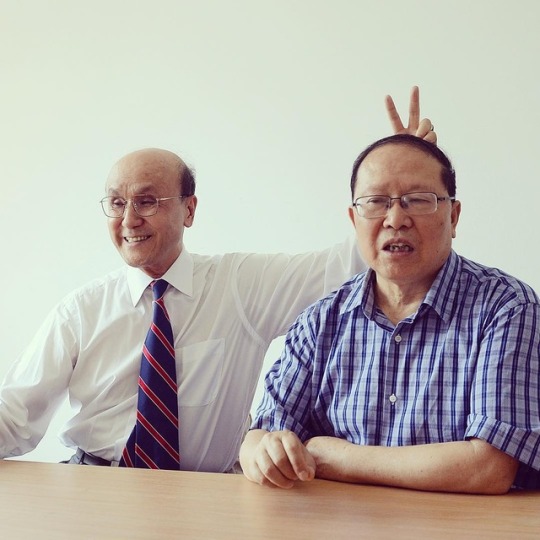
One is never too old to learn. Huang Zushen, 74, proved the old saying by earning his PhD and becoming the oldest doctoral graduate at Sichuan University after four years of study on Friday.
“Huang’s work has filled the gap,” his supervisor Chen Tingxiang, who’s six years younger than Huang, commented.
11 notes
·
View notes
Text
The Magellanic Clouds
We look up to the sky and see stars, blinking far away from us, take something more powerful and we can see planets, moons, asteroids and even dwarf planets. I often wonder what it all would look like, the other way round?
Looking at the great spiral that is the milky way a kind of motion in celestial stillness. Zooming out more, we look at other galaxies, feels almost like they're chasing each other, playing around an elderly, that is the milky way, these are the Magellanic clouds orbiting the milky way. These two Magellanic clouds are alive and still fertile, hence have had our attention since 20th September 1966. Most galactic satellites are dead in this context the gargantuan gravitational force of the parent galaxy usually robs them of their gas in the process known as tidal stripping, without gas, there can be no stars. It can be seen that the milky way galaxy is not only a home to a billion of humans, it also keeps the Magellanic clouds alive, just like any mother looking after her children.
An astronomer named Gurtina Besla from Columbia University suggested that the smaller Magellanic clouds smashed right through the larger, triggering an accelerated star creation and leaving most of the stars behind. As the Milky Way’s gravity gently tugs on its neighbour’s gas clouds, they collapse to form new stars. In turn, these light up the gas clouds in a kaleidoscope of colours, which is visible in this image taken by NASA/ESA Hubble Space Telescope.
It’s noteworthy that so openly and yet so unnoticeably the acts of nature mimic our emotional thoughts. As the Magellanic clouds move closer towards the milky way, the nearer is pulled away from its partner and is left at such a distance as would make it impossible to unite again. The closer we move towards a person, the more we involve ourselves into someone, we get dependent on them just like that star, and when we move further away from them, we’re in a weird way left gasless, like a dwarf spheroidal. Finding that equilibrium, such as between the two Magellanic clouds and milky way is what keeps them alive, alive, fertile, and loveable.
Source : -
#stars#space#astonomy#nerdwriter#love#large magellanic cloud#magellanic clouds#emotions#alive#milky way#planets#tidal stripping#nasa#esa#hubble#nature#thoughts#light#lovely#sad#melancholy#melancholic#juvenil#deep#understanding#universe#black
0 notes
Photo
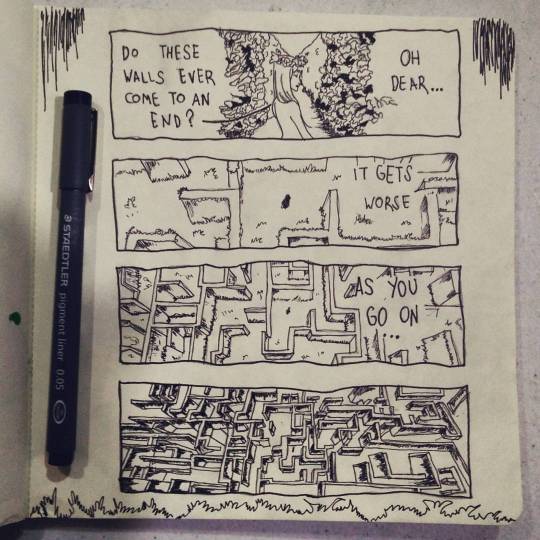
“Do these walls come to an end?” - Garden Maze
5 notes
·
View notes
Conversation
Achilles: Name one hero who was happy.
Patroclus: Perseus.
Achilles: ...goddammit man
380 notes
·
View notes
Photo
😪😪. Will never be able to...
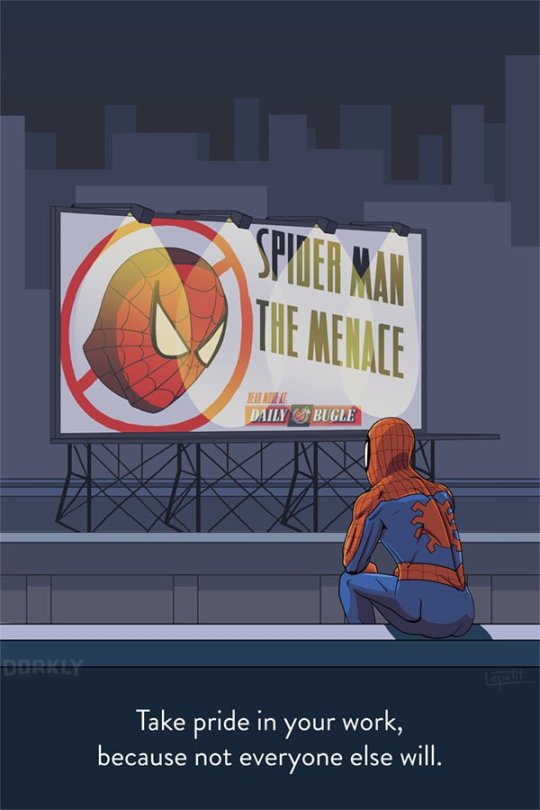

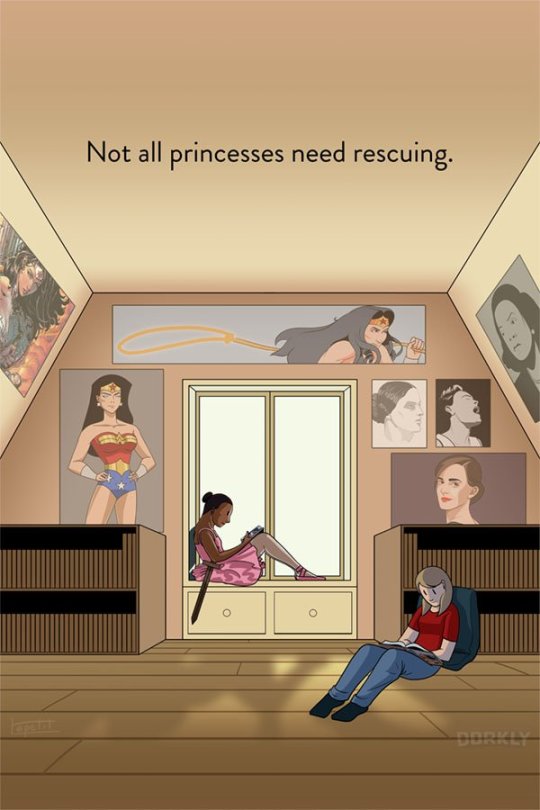

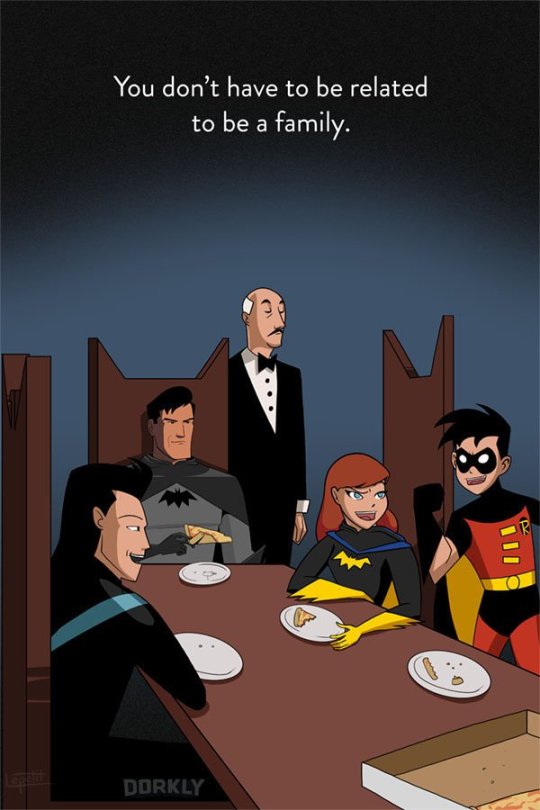

6 Things We Can All Learn From Superheroes > Julia Lepetit and Tristan Cooper
80K notes
·
View notes
Photo
Shut up! And take my money!! 😝😝


The tempescope is an ambient physical display that visualizes various weather conditions like rain, clouds, and lightning. By receiving weather forecasts from the internet, it can reproduce tomorrow’s sky in your living room.
638K notes
·
View notes
Audio
😂😂😂 Can't stop laughing.

I JUST CANT FUCKING STOP LAUGHING BECAUSE THIS WAS PLAYING WHEN I SAW THIS GIF AND.
137K notes
·
View notes

